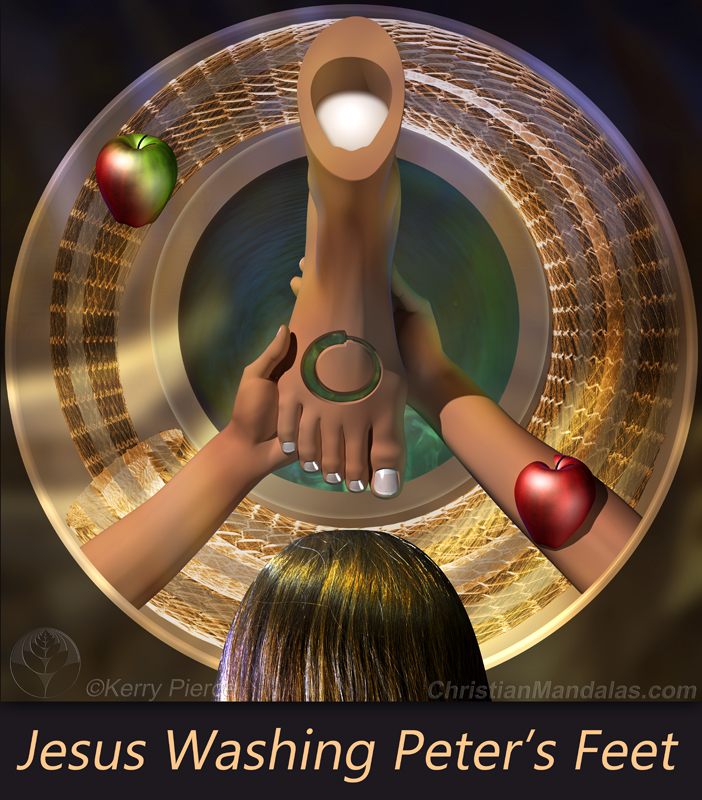
The Christian Mandala™ shown, Jesus Washing Peter’s Feet, depicts the event described in John 13 during the Passover meal. Overall, washing the disciple’s feet is a visual object lesson that Jesus gives to his disciples.
Visualization is why we created the Christian Mandala curriculum.
Dear Jesus, what are you up to?
Context. In first-century Palestine, it was common to wear sandals. The roads in Palestine were dirt. Dirty and dusty, turning to mud in the rain. It was typical to go barefoot in the house, so the first duty of the host of a meal was to wash the guests’ feet before their entry. Foot washing before a feast was a task usually performed by slaves.
The first point of the lesson is humility and service. As the theologian, Frederick Dale Bruner writes in his commentary on the Gospel of John, “There is no parallel in [existing] ancient literature for a person of superior status voluntarily washing the feet of someone of inferior status.” Here we find God in the flesh performing the work, giving his disciples a lesson in humility and Christian service.
The second point of the lesson is symbolic. A comparison is made between the cleansing of feet to the purification of a person’s soul. Jesus’ washing of feet is symbolic of his work on the cross, which cleanses the souls of believers, enabling them to enter into intimate fellowship with our Lord.
The lesson: By accepting to allow Jesus to wash your soul, you gain access to God, learn the importance of service and join in the heavenly feast.
Quick theological deep dive. Consider the Day of Atonement, the holiest day of the Hebrew calendar year. On this day, Israel’s High Priest will enter into the Holy of Holies in the Tabernacle. In doing so, he enters into the very presence of God to make a comprehensive act of atonement for the People of Israel. The purpose of this ceremony is to bridge the gap between a Holy God and the People of Israel.
As part of the ritual, the High Priest will wash his hands and feet a number of times. The High Priest is physically washing, but there is also a spiritual cleansing enabling the High Priest to enter into the presence of God.
Jesus’ washing of the disciples’ feet is a spiritual cleansing enabling the disciples to themselves become a royal priesthood and a holy nation. They are enabled to receive the Holy Spirit, which Jesus breathes on them in John 20.
Image explanation. Peter’s foot is in the center of the image. Christ’s hands hold Peter’s foot above a basin of water. We see the back of Jesus’ head in the lower portion of the picture as he kneels in humility. The apple is a Christian symbol for sin. Jesus will wash the sin from Peter and take it upon himself. This action is depicted as the apple’s removal from the upper portion of the foot and transference to Jesus’ right arm. Note that the area of the foot vacated by the apple turns white, indicating that Jesus makes all believers a holy place.
The ouroboros is not a common symbol. My rendering of the ouroboros is a stylized depiction of a snake eating its own tail. I’m using the ouroboros symbol to represent self-centeredness. In time, self-centeredness in the believer is replaced with Christ-centeredness. The ouroboros, like the apple, is removed from the foot. In effect, the snake and the apple, self-centeredness and sin, are removed from the individual. The believer is born-again and becomes more and more like Christ each day.
The reflection of Christ’s face is shown in the water below Peter’s foot.
As an aside, if you’ve taken Calculus, you might recognize the ouroboros. In a mathematical context, the ouroboros may be referred to as an ordinary torus whose minor radius is a variable which linearly decreases. A mathematical function which the Dutch graphic artist M. C. Escher called “a self-centered sort of thing.”
